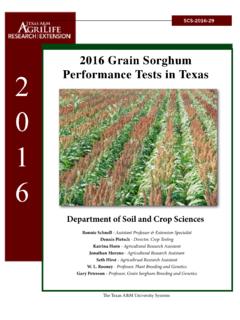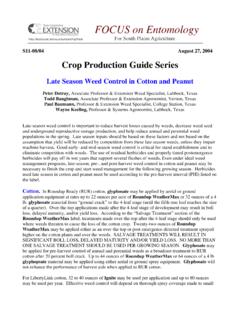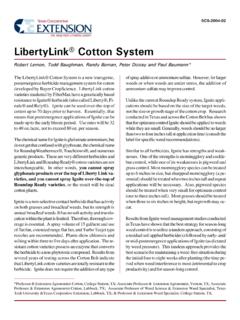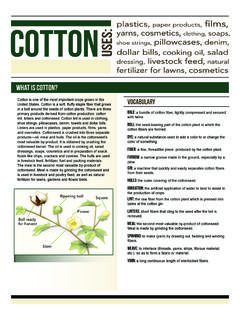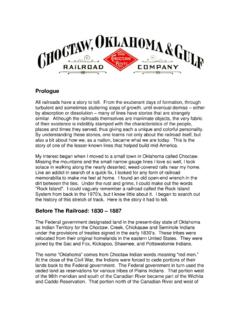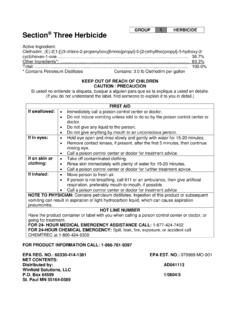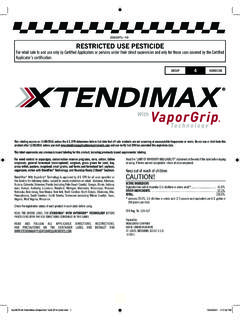Transcription of Crop Production Guide Series - varietytesting.tamu.edu
1 S9-06/04 June 22, 2004 Crop Production Guide Series Mid-Season weed Control in cotton and Peanut Peter Dotray, Associate Professor & Extension weed Specialist, Lubbock, texas Todd Baughman, Associate Professor & Extension Agronomist, Vernon, texas Paul Baumann, Professor & Extension weed Specialist, College Station, texas Wayne Keeling, Professor & Systems Agronomist, Lubbock, texas Herbicides applied preplant incorporated (PPI) and preemergence (PRE) vary in length of time they persist in the soil to control weeds. Soil and environmental factors, the specific herbicide and rate applied, tillage, and irrigation will influence the length of herbicide residual activity.
2 Good early-season weed control is critical to ensure uniform crop stand and eliminate competition with weeds. Mid-season weed control is important because of the frequent early to mid-season emergence of weeds and weed escapes. This weed emergence may be attributed to the fact that some weeds germinate all season long; earlier herbicide applications have lost their residual effectiveness; and/or high weed seed density in the soil. Mid-season weed control can be achieved bseveral weed management practices. Cultivation is an effective means to control many weeds. Shallow cultivation is generally enough to control small annual weeds and will reduce competition from perennial weeds for a limited time. Cultivation can harm cotton and peanut by pruning roots. In addition, it may harm peanut by covering the lowest lateral branches, which may inhibit normal flowering, pegging, and pod set.
3 Soil tfavorable conditions for diseases such as southern blight. y hrown on the crown and lateral branches may create more otton. Several herbicides are available for conventional and herbicide tolerant cotton varieties. ded or d Wylie shielded sprayer CWith the exception of Staple and the postemergence grass herbicides Assure II, Fusilade, Fusion, Poast Plus, Select/Arrow (which can be applied postemergence-topical (POST over-the-top); herbicides must be applied postemergence-directed (POST-DIR) with the use of a hooded/shieldirected sprayer. The purpose of POST-DIR applications is to apply herbicides to smaller weeds beneath the crop canopy. Therefore a height differential between the crop and weed is important because weeds growing in the row that are the same height as cotton will not be thoroughly coverewith the herbicide and control will be less than adequate.)
4 POST-DIR herbicides are sprayed towardsthe base of the cotton . Herbicide contact on leaves and fleshy, green stems may injure cotton . The barky stem at the base of cotton increases crop tolerance. MSMA/DSMA may be applied POST-DIR when cotton is 3-inches high to first bloom. Do not apply after first bloom. MSMA and DSMA are effective on small annual grasses, cocklebur, and nutsedge. To broaden the weed spectrum controlled, MSMA/DSMA is often used in combination with one of the other POST-DIR herbicides. Caparol (prometryn), Cotoran (fluometuron), Direx and Karmex (diuron), and Linex and Lorox (linuron) will help control existing weeds plus provide residual weed control. The use of MSMA with these products will also heat up the activity of these herbicides on the weeds and the crop if contacted.
5 These herbicides have activity on a large number of annual grasses and broadleaf weeds. Some of their strengths are mentioned below. Caparol: annual morningglory; Cotoran: annual nightshade, lanceleaf sage (mintweed), Venice mallow (flower-of-an-hour); Direx: pigweed (carelessweed), cocklebur, sunflower; Linex: pigweed. Layby Pro is a new premix of linuron and diuron for use POST-DIR. Aim and ET may be used POST-DIR to actively growing weeds up to 4-inches in height. Valor is a new option POST-DIR in cValor has good burn down activity on a variety oannual broadleaf weeds and has about 4 weeks of residual activity on morningglory and other broadleaves. Do not spray tender cotton stems because plant lodging may occur. ET should only be applied through a hooded/shielded sprayer while cotton plant size will determine the proper equipment needed for Aim and Valor.
6 Gramoxone Max can be applied only through a hooded sprayer to control small annual grasses and small broadleaf weeds such as kochia and Russian thistle in the row middles. Cobra and Goal are two additional herbicides labeled for POST-DIR applications in cotton that may be add activity on troublesome weeds such as annual morningglory. otton. f Wylie shieldWylie hood Read the label to determine proper rates, application timings, spray additives, tank-mixes, weeds controlled and equipment needed with all POST-DIR herbicides. Try to keep spray mist of products such as Aim, ET, and Valor off the cotton and consider the use of lower spray pressures or spray tips that offer drift reduction without sacrificing coverage. Herbicides applied under hoods that are run along the ground will minimize herbicide contact on cotton leaves and stems better than herbicides applied with shielded sprayers, but thorough coverage of weeds growing in the cotton row is more challenging when using hooded sprayers.
7 John Deere hooded sprayer In Roundup Ready cotton , Roundup (WeatherMax and other glyphosate formulations) applications must be made POST-DIR after the cotton has exceeded the four-leaf growth stage. Spray solution must be directed away from the foliage and towards the base of the cotton stalk to minimize herbicide contact. Because glyphosate does not have soil activity, a tank mix with a residual herbicide such as Caparol, Direx, Staple, or Dual Magnum can extend the weed control. Ignite in LibertyLink cotton may be applied POST or POST-DIR mid-season. Ignite is a contact herbicide, so thorough coverage on small weeds is important. A carrier volume of 15 (to 18) gallons of water is recommended when using Ignite. Ignite may be applied alone or in a tank mix with a residual herbicide such as Staple.
8 Buctril may be applied POST or POST-DIR in BXN cotton mid-season. Buctril is similar to Ignite in that it is most effective on small, actively growing weeds. Thorough spray coverage is important. POST-DIR applications of these herbicides may aid in increasing weed coverage in larger cotton . Peanut. There are several herbicide options for use POST in peanut mid-season. These herbicides are identical to the list provided for early season weed control because there are no additional herbicides that may be used POST-DIR. Cadre and Pursuit have broad-spectrum activity on several annual grass and broadleaf weeds and nutsedge. Basagran, Ultra Blazer, and Storm are effective on several annual broadleaf weeds. Because these products are contact herbicides, thorough coverage on small weeds will significantly increase effectiveness.
9 2,4-DB plus crop oil has activity on several annual broadleaf weeds and some hard-to-control perennial broadleaf weeds such as silverleaf nightshade and Carolina horsenettle. However, this combination will likely cause the peanut canopy to lie down for a few days after application. 2,4-DB can be tank mixed with other POST herbicides to broaden the spectrum of weed control. Since 2,4-DB does not have soil activity, a tank mix with several herbicides (Cadre, Pursuit) that have soil activity will lengthen the time weeds are controlled after application. Be careful of 2,4-DB drift on susceptible crops such as cotton . Do not apply 2,4-DB within 30 days of harvest. Select and Arrow (clethodim) and Poast Plus are effective graminicides that may be used in peanut.
10 Follow label recommendations to determine the maximum number of applications, total herbicide amount allowed in-season, and the pre-harvest interval for all of these herbicides. Crop Production Guide Series , a supplement to FOCUS on Entomology newsletter, is published by texas Cooperative Extension Route 3, Box 213AA Lubbock, TX 79403 Fair Use Policy for FOCUS information: We do not mind if others use the information in FOCUS for their own purposes, but please give FOCUS the appropriate credit when you do. Images may or may not be copyrighted by the photographer or an institution. They may not be reproduced without permission. Call 806-746-6101 to determine the copyright status of images. Editor: James F. Leser Associate Editor & Graphic Designer: Michelle Coffman For more information call or e-mail: 806-746-6101 or Educational programs conducted by texas Cooperative Extension serve people of all ages regardless of socio-economic level, race, color, sex, religion, handicap or national origin.
